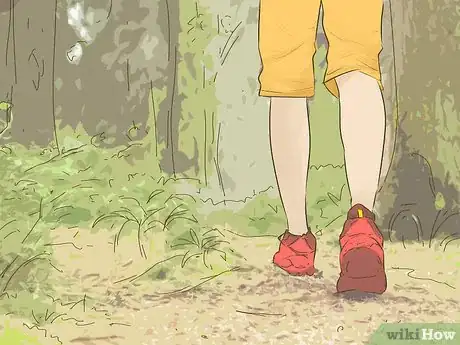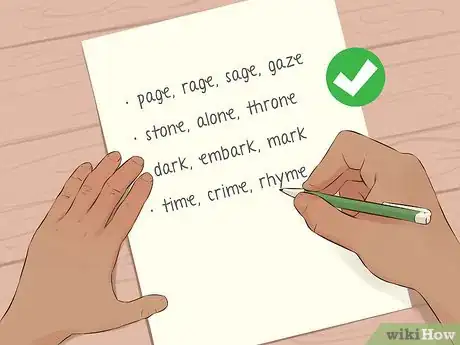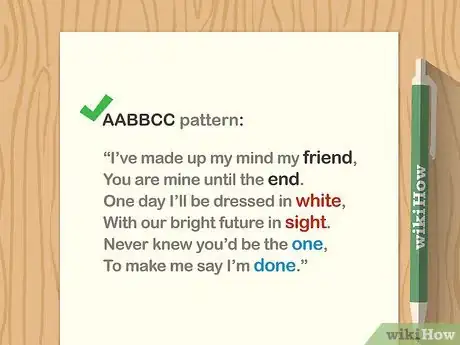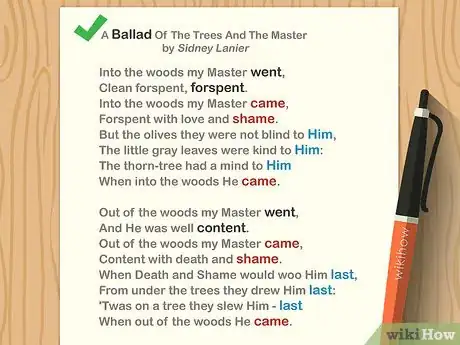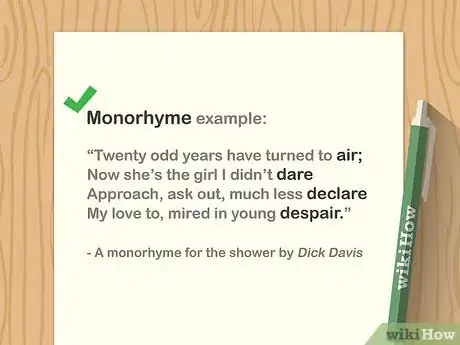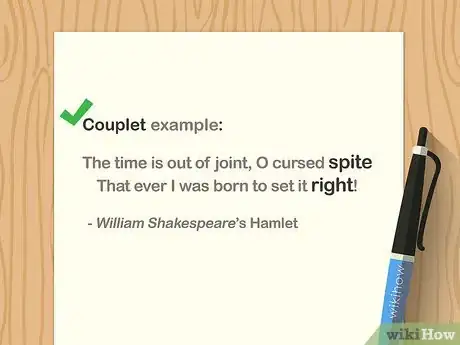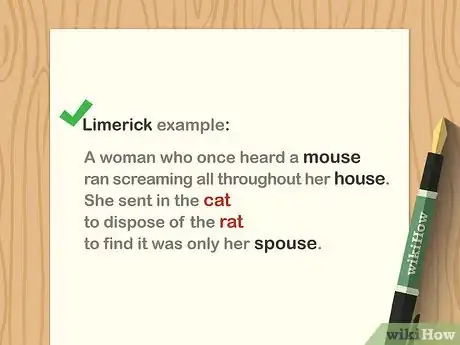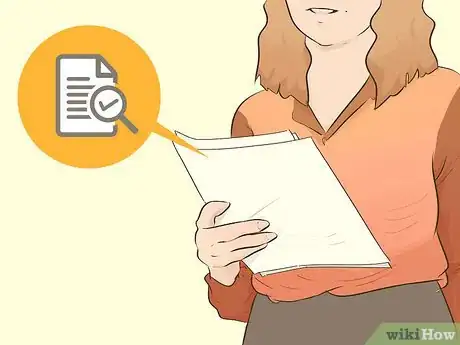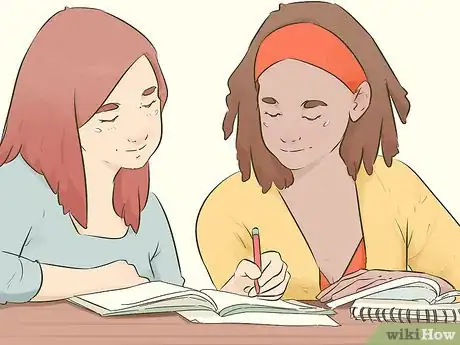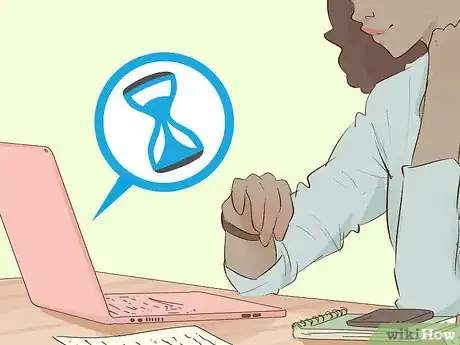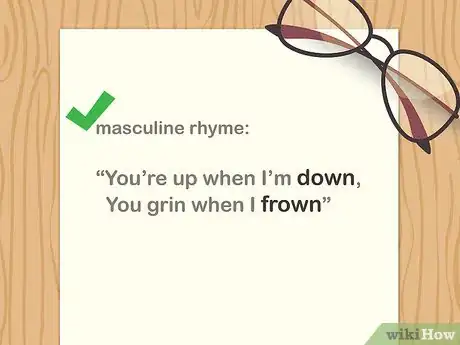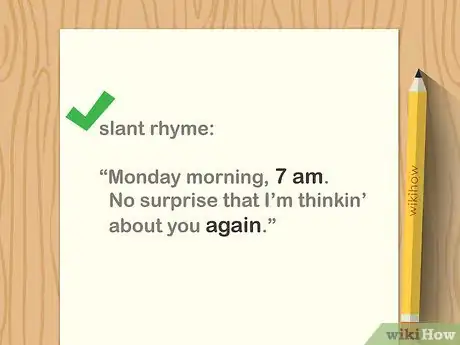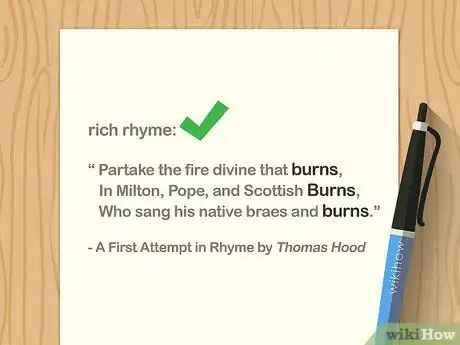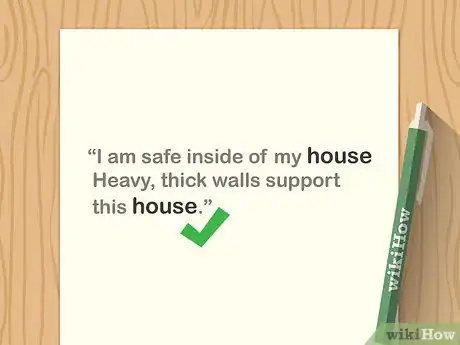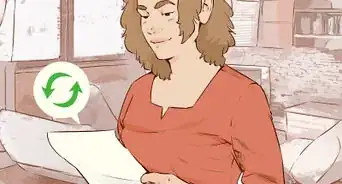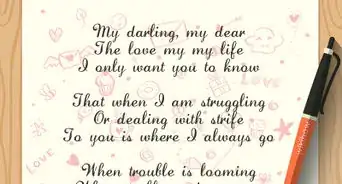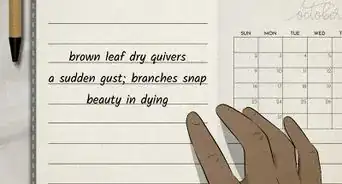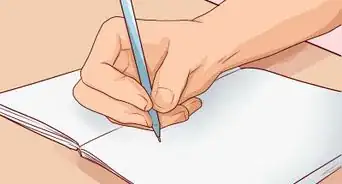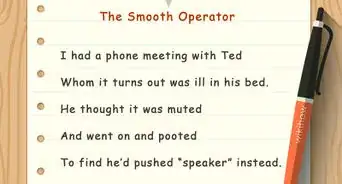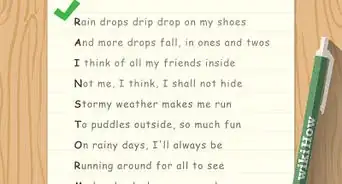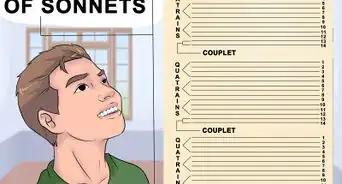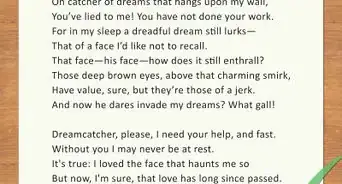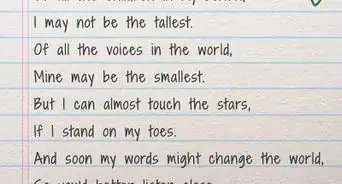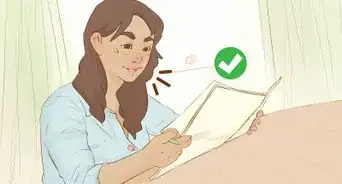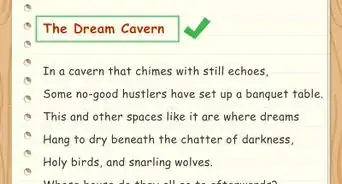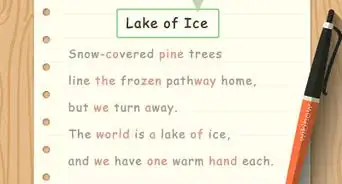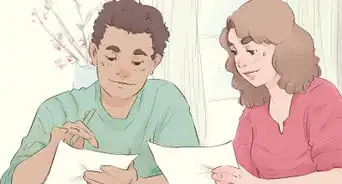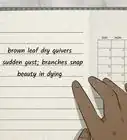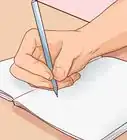This article was co-authored by Alicia Cook. Alicia Cook is a Professional Writer based in Newark, New Jersey. With over 12 years of experience, Alicia specializes in poetry and uses her platform to advocate for families affected by addiction and to fight for breaking the stigma against addiction and mental illness. She holds a BA in English and Journalism from Georgian Court University and an MBA from Saint Peter’s University. Alicia is a bestselling poet with Andrews McMeel Publishing and her work has been featured in numerous media outlets including the NY Post, CNN, USA Today, the HuffPost, the LA Times, American Songwriter Magazine, and Bustle. She was named by Teen Vogue as one of the 10 social media poets to know and her poetry mixtape, “Stuff I’ve Been Feeling Lately” was a finalist in the 2016 Goodreads Choice Awards.
There are 10 references cited in this article, which can be found at the bottom of the page.
This article has been viewed 794,238 times.
Rhyme can add a driving music to your poems, giving them a memorable quality that can be a lot of fun. While not all poems need to rhyme, poems that do rhyme tend to seem all the more spectacular for pulling off such a complex composition. If you want to try your hand at rhyming poetry, learn the basics, get inspired, and write your poem!
Steps
Brainstorming Your Poem
-
1Jot your ideas down as they come to you. It is important to write often to keep your creative juices flowing and to ensure that you don’t forget the ideas that you have for poems! When you have an idea for a poem, write it down so you won’t forget it.[1]
- You don’t have to write your ideas in verse. You can write in prose or make lists of words and ideas that you might want to use for a poem later on.
- It's a good idea to start by choosing the concept or topic of your poem—what do you want it to be about? Then, you can start shaping words around the topic.[2]
Tip: Keep a small notepad or journal with you at all times so you can record your ideas and write on the go.
-
2Look around for inspiration. If you are not sure what to write your poem about, pick an object, animal, person, or place as your subject matter. You don’t need to write about something extraordinary. Just choose something that is interesting to you.
- For example, you could choose to write a rhyming poem about a lamp on your desk, the view out your bedroom window, your dog, your mom, or your favorite restaurant.
Advertisement -
3Write freely about your chosen topic. Once you have an idea for a poem, start writing! Get all of your ideas for the poem onto paper without worrying about the structure or rhyme scheme. You can divide it into lines, or write it in prose as your first draft.
- For example, if you are writing a poem about your dog, then you might write a paragraph about how your dog looks, acts, and makes you feel.
Tip: If you spot any opportunities for rhyming in your draft, include these rhyming words. However, you can also add these later, so don’t worry if you can’t think of any right away.
-
4Make a list of rhyming words for your subject. Another great way to brainstorm for a rhyming poem is to make a list of rhyming words that are related to your subject. The list may be long or short depending on what you are writing about. Try writing words that describe the subject and then look for rhyming pairs to each of those words.[3]
- For example, if you are writing a poem about your favorite tree, then you might start by writing down words that rhyme with tree, such as see, me, we, glee, free, memory, etc.
- Then, you could choose a part of the tree, such as the bark, and make another list of words that rhyme with bark, such as park, mark, stark, dark, embark, and lark.
- Continue making lists in this way until you cannot think of any more words.
- Use a rhyming dictionary if you get stuck on finding a rhyme for a word.[4]
Selecting a Rhyme Scheme
-
1Opt for an alternating rhyme scheme for a simple pattern. The alternating rhyme scheme may be the most common way to organize a poem. To use it, place your rhyming pairs at the end of every other line.[5]
- For example, your rhyming words would follow the pattern ABAB, CDCD, EFEF, etc.
-
2Try out a ballade structure for something more complex. If you want to incorporate a little more complexity into an alternating rhyme scheme, then try structuring your poem in ballade form. This features 2 sets of 4 alternating rhymes divided by 1 extra line that rhymes with the second line. Then, a third set of 4 alternating rhymes that features the same rhymes as the second set follows.[6]
- For example, this rhyme scheme would look like ABABBCBC and then BCBC.
-
3Rhyme all of the words in the poem with each other for a monorhyme. Monorhyme is when you use the same rhyming sound throughout your entire poem. This can be tricky if there are not a lot of words or syllables that rhyme with your first word, so choose carefully.[7]
- For example, the last word in each line in your poem would rhyme with the first one you used, so the rhyme scheme would look like AAAAA.
-
4Write couplets for a simple way to organize your rhymes. A couplet is simply 2 lines that end with the same rhyme. You can write your entire poem in couplets, or just include a few for variety.[8]
- A poem written in a couplet rhyme scheme would look like AA BB CC DD etc.
- You can also do a variation of the couplet by writing triplets, such as AAA BBB CCC etc.
For example, a couplet can be as simple as, "The cow jumped over the moon, and the dish ran away with the spoon."
-
5Start and end each stanza with the same rhyme for an enclosed rhyme. If you want to try something that will help to signal the beginning and then end of your stanzas, then open and close each one with the same rhyme. You can include a couplet or other rhyme scheme in the middle of the stanza, or not include any other rhymes except for at the beginning and end of the poem.[9]
- For example, you could organize your rhyme scheme as ABBA CDDC EFFE, or try something like ABCA DEFD GHIG.
-
6Go with a Limerick structure for a funny poem. Limericks are 5 line poems that tell a short silly story, so this is a great option if you want to write a funny rhyming poem. The Limerick structure includes 2 couplets followed by 1 line that ends on the same rhyme as the first couplet.
- For example, you could structure your poem as AABBA.
-
7Include 2 or more rhyming words in the same line. You can also place rhyming words within the same line for a quicker succession of rhymes. This is known as an internal rhyme scheme. Choose 2 words that rhyme or that have a rhyming syllable at the end and place them both in the same line in your poem.[10]
- For example, you might include a rhyme that reads, “Stealthily I stalk along the walk,” or “Beauty is my solemn duty.”
Revising a Rhyming Poem
-
1Read through your poem a few times after drafting it. As with many forms of writing, revision is the most important part. Once you have your ideas on paper, go back through it and fix grammatical mistakes, refine the language, add or remove words and phrases, and rewrite sections of the poem as needed.
- Make sure to read your poem out loud so that you can hear how it sounds. This will help you to catch minor errors and this is also how poetry is meant to be enjoyed![11]
- If you have to submit the poem for a class, make sure that you give yourself plenty of time to revise your poem until you are happy with it! Remember that even published poets revise their work multiple times.
-
2Get feedback from someone you trust. Ask a friend, classmate, or teacher to read over your poem and tell you what they think. This may help you to revise your poem by providing you with additional rhyming words, content for the poem, or ways to improve the structure.
- If you need to submit the poem for a class, be sure to ask for feedback at least a few days before the poem is due.
Tip: Keep in mind that revising is not just about fixing minor errors such as misspellings, typos, or formatting issues. Revising is about shaping and improving the content of your poem to make it as good as possible.[12]
-
3Come back to the poem in a few hours or days if you are stumped. Although you can revise your poem right away, many people find it easier to revise after they have set their poem aside for a few hours or even a few days. This allows you to return to the poem with fresh eyes and spot issues that you ay not have noticed the last time you looked at it.
Trying Different Kinds of Rhymes
-
1Make the last word in a line rhyme with the last word in the next line. The most common type of rhyme in a poem is when the last word or the last syllable of the last word in a line rhymes with the last word or syllable of another line.[13] This is also known as a masculine rhyme.[14]
- For example, if 1 line ends with “shells,” then next line might end with “bells.”
- Or, you could rhyme the last syllables to 2 words, such as “rotisserie” and “misery.”
-
2Pair 2 words that almost rhyme for a slant rhyme scheme. When you have 2 words in a poem that are similar in sound but not quite close enough to rhyme perfectly, this is known as a slant rhyme scheme. The words might have a strong rhyming vowel sound, but be 1 consonant or vowel off from rhyming perfectly.[15]
- For example, the words “heart” and “star” are a slant rhyme because of the “arr” sound in each of the words. “Silk” and “talk” would also be considered a slant rhyme because both words share the “lk” at the end.
- Slant rhyme is also sometimes referred to as feminine rhyme.[16]
-
3Repeat homonyms to incorporate rich rhyme. Rich rhyme is so named because the rhyming words sound the same but have totally different meanings. This is a great way to incorporate rhyming words and add intricacy to your poem.[17]
- For example, you might include the words “bare,” as in naked, and “bear,” as in carry or like the animal.
- Another type of rich rhyme might be repeating the word “rose,” but with a different meaning in each use. “Rose” can mean that someone stood up, or that something climbed higher in the sky, such as a bird, dust, or the sun, or it might also refer to the flower.
-
4Include eye rhymes with words that look like they rhyme but don’t. Some words are spelled in such a way that you might think they rhyme when you see them on paper. However, the 2 words might sound totally different when you speak them. Pairing 2 words that look the same but sound different is called an eye rhyme and including these types of rhymes can make your poem seem more intricate.[18]
- For example, the words “tough” (pronounced as TUFF) and “bough” (pronounced as BOW) have the same spelling after their consonants, so it seems like they would rhyme, but they sound very different when you say them!
-
5Use the same word more than once to emphasize it. Repeating a word is another creative way to include rhyming words in your poem. You can rhyme a word with that same word by repeating the word in the same position in the next line.[19]
- For example, you could repeat “house” in 2 lines by saying, “I am safe inside of my house / Heavy, thick walls support this house.”
Tip: Don’t reuse the same word too many times in your poem. Try using repetition only once or twice to create emphasis without sounding too repetitive.
Fill in the Blank Template for Rhyming Poem
Expert Q&A
Did you know you can get premium answers for this article?
Unlock premium answers by supporting wikiHow
-
QuestionHow do I start my poetry?
 Alicia CookAlicia Cook is a Professional Writer based in Newark, New Jersey. With over 12 years of experience, Alicia specializes in poetry and uses her platform to advocate for families affected by addiction and to fight for breaking the stigma against addiction and mental illness. She holds a BA in English and Journalism from Georgian Court University and an MBA from Saint Peter’s University. Alicia is a bestselling poet with Andrews McMeel Publishing and her work has been featured in numerous media outlets including the NY Post, CNN, USA Today, the HuffPost, the LA Times, American Songwriter Magazine, and Bustle. She was named by Teen Vogue as one of the 10 social media poets to know and her poetry mixtape, “Stuff I’ve Been Feeling Lately” was a finalist in the 2016 Goodreads Choice Awards.
Alicia CookAlicia Cook is a Professional Writer based in Newark, New Jersey. With over 12 years of experience, Alicia specializes in poetry and uses her platform to advocate for families affected by addiction and to fight for breaking the stigma against addiction and mental illness. She holds a BA in English and Journalism from Georgian Court University and an MBA from Saint Peter’s University. Alicia is a bestselling poet with Andrews McMeel Publishing and her work has been featured in numerous media outlets including the NY Post, CNN, USA Today, the HuffPost, the LA Times, American Songwriter Magazine, and Bustle. She was named by Teen Vogue as one of the 10 social media poets to know and her poetry mixtape, “Stuff I’ve Been Feeling Lately” was a finalist in the 2016 Goodreads Choice Awards.
Professional Poet
-
QuestionWhat is a rhyming scheme?
 wikiHow Staff EditorThis answer was written by one of our trained team of researchers who validated it for accuracy and comprehensiveness.
wikiHow Staff EditorThis answer was written by one of our trained team of researchers who validated it for accuracy and comprehensiveness.
Staff Answer wikiHow Staff EditorStaff Answer
wikiHow Staff EditorStaff Answer -
QuestionHow do you write a short poem?
 wikiHow Staff EditorThis answer was written by one of our trained team of researchers who validated it for accuracy and comprehensiveness.
wikiHow Staff EditorThis answer was written by one of our trained team of researchers who validated it for accuracy and comprehensiveness.
Staff Answer wikiHow Staff EditorStaff AnswerThe great thing about writing poems is that you can structure them almost any way you like. To write a very simple short poem, just come up with a rhyming couplet (2 lines that rhyme and have the same meter, or pattern of stressed and unstressed syllables). For example, you could write an ultra-short rhyming poem like Strickland Gilliland’s “Fleas,” which reads in full: “Adam / Had ‘em.”
wikiHow Staff EditorStaff AnswerThe great thing about writing poems is that you can structure them almost any way you like. To write a very simple short poem, just come up with a rhyming couplet (2 lines that rhyme and have the same meter, or pattern of stressed and unstressed syllables). For example, you could write an ultra-short rhyming poem like Strickland Gilliland’s “Fleas,” which reads in full: “Adam / Had ‘em.”
Warnings
- Don't get angry or stressed if you're having a hard time. Take a break to clear your mind, have a drink of water or get some fresh air, and start again.⧼thumbs_response⧽
References
- ↑ https://theadroitjournal.org/2020/04/03/the-benefits-of-writing-down-your-thoughts-and-feelings/
- ↑ Alicia Cook. Professional Writer. Expert Interview. 11 December 2020.
- ↑ Alicia Cook. Professional Writer. Expert Interview. 11 December 2020.
- ↑ Alicia Cook. Professional Writer. Expert Interview. 11 December 2020.
- ↑ https://examples.yourdictionary.com/common-rhyme-scheme-examples-in-poetry.html
- ↑ https://literarydevices.net/rhyme-scheme/
- ↑ https://literarydevices.net/rhyme-scheme/
- ↑ https://literarydevices.net/rhyme-scheme/
- ↑ https://literarydevices.net/rhyme-scheme/
- ↑ https://www.litcharts.com/literary-devices-and-terms/internal-rhyme
- ↑ https://writingcenter.unc.edu/tips-and-tools/revising-drafts/
- ↑ https://writingcenter.unc.edu/tips-and-tools/revising-drafts/
- ↑ https://study.com/academy/lesson/masculine-rhyme-definition-examples.html
- ↑ https://www.poetryfoundation.org/learn/glossary-terms/rhyme
- ↑ https://www.dailywritingtips.com/types-of-rhyme/
- ↑ https://www.poetryfoundation.org/learn/glossary-terms/rhyme
- ↑ https://www.dailywritingtips.com/types-of-rhyme/
- ↑ https://www.dailywritingtips.com/types-of-rhyme/
- ↑ https://www.dailywritingtips.com/types-of-rhyme/
- ↑ https://www.poetryfoundation.org/
About This Article
To write a rhyming poem, start by choosing a subject and making a list of rhyming words that are related to the subject. Then, use these words to write lines using a rhyme scheme such as ABAB, meaning the first and third line rhyme, as do the second and fourth. Additionally, try making each line the same number of beats, or syllables, to add structure to your poem. To learn more, including how to organize your lines into verses like couplets and sonnets, read on!


